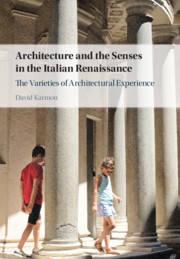2 results
Chapter 3 - The Literature of Neighborhood
- from City Spaces
-
-
- Book:
- The City in American Literature and Culture
- Published online:
- 06 August 2021
- Print publication:
- 05 August 2021, pp 57-69
-
- Chapter
- Export citation

Architecture and the Senses in the Italian Renaissance
- The Varieties of Architectural Experience
-
- Published online:
- 30 April 2021
- Print publication:
- 27 May 2021

